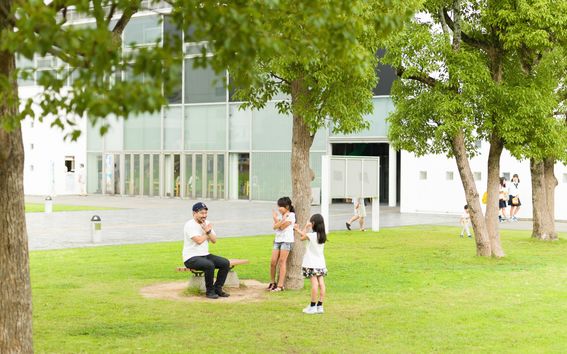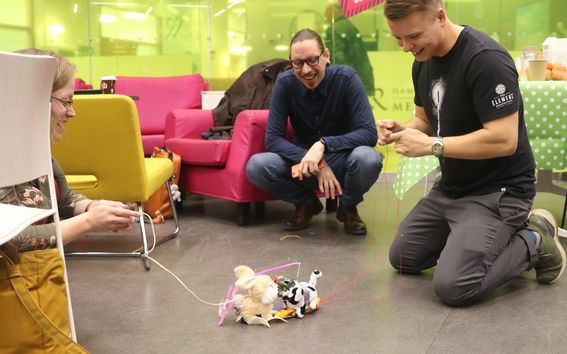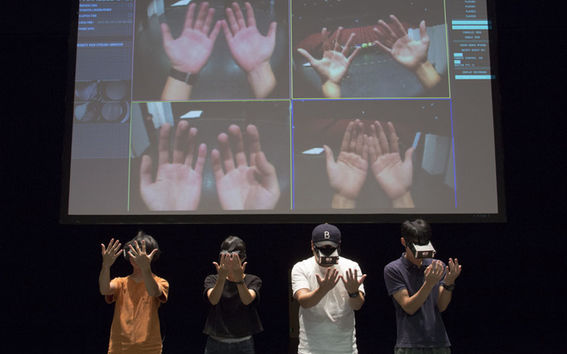Aiming at improving media literacy

What did you work on with as a visiting researcher at Aalto University?
From August 2019 to March 2020 I joined the Learning Environments Research Group (LeGroup), led by Associate Professor Teemu Leinonen, to learn about SySTEM 2020, a project funded by the European Union for connecting science learning outside the classroom. SySTEM 2020 aims to tackle scientific literacy and STEAM – Science, Technology, Engineering, Art, Maths – education of children and teenagers across Europe.
For someone who works as a museum educator like me, this project really matches interests. I have a background in creating technology-based learning materials, but I had little expertise about how to theorize the creation of learning materials and evaluate the effect of them. I have learned a lot, and it's really encouraging.
You collaborated in the organization of an Hebocon event, consisting of a robot-building workshop and a tournament, at Iso Omena earlier this year. What was the meaning of the event?
Hebocon is a crappy robot tournament for anyone who does not have the actual technical skills to build robots. The Japanese adjective ‘heboi' is used to describe something that is technically poor, or low in quality. The object of Hebocon is to enjoy ‘heboiness’, so the event is meant to be of a low threshold, open for anyone interested in robots.
The Hebocon workshop in Finland was part of research on SySTEM2020 exploring how to support science learning outside the classroom amongst minority groups in science education, with special attention to young people who are at risk of social exclusion. The main participants were personnel working in public libraries and youth centers.

During the morning of the workshop day, participants each made a robot. We used toys that had been gathered at recycling centers and libraries in Finland as some of the materials for the robots. In the afternoon, we held a tournament, where these robots were fighting against each other, following the rules of Japanese sumo wrestling. The audience even included elementary school children from the local area, and the event was a great success.
In the co-design workshop part that followed, we had feedback and discussions and asked the participants for their valuable opinions on the possibility of holding Hebocon at public libraries and civic centers. We now plan to analyze the data we collected, and proceed with our research.
Personally, I see great potential in maker spaces, called ‘paja', which have been established in public libraries in Finland. I plan on bringing the expertise I gained here back to libraries in Japan and putting it to use.
Could you tell us about your work at the Yamaguchi Center for Arts and Media, and the center itself?
Before coming to Aalto University, I worked as a museum educator for about ten years at Yamaguchi Center for Arts and Media (YCAM). It is an art center established by Yamaguchi City and opened in 2003. This facility aims to explore the possibilities of artistic expression by utilizing media technology in a modern information society.
I specialize in working together with artists, programmers, engineers and researchers for the development of learning programs. As a means of improving media literacy amongst the public, I have researched and developed workshops that focus on the relationship between people and society, the human body and media technology.
Beyond simply improving people's media literacy and strengthening their knowledge, we work to introduce new perspectives into their daily lives, which foster greater creativity and imagination, enabling them to see the world around them in an entirely new light. Our educational approach is primarily practical, focusing not so much on ‘learning about technology’ but, rather, ‘learning with technology’ and ‘thinking from a technological standpoint’.
What is the main message you aim to convey through your work on media technology?

As technology advances, we should keep ourselves updated with the technological situation changing day by day. Its influence extends to our expertise, communication, ethics, and social lives. Through the development of educational programs, such as workshops, I have been looking for ways to comprehend media technology in a physical and intuitive way. I would be happy if I could continue supporting the development of new media literacy, in response to the changing times.
Our modern society has a particularly hard time predicting the future. I want to keep conveying a mindset, especially to our younger generations, that enjoys change and is able to constantly keep learning in a flexible way.
What are the best ways to support participation of general public in current debates about technology?
I believe we should keep increasing not only discussions by means of words and letters, but also places and communities where people can move their bodies and learn about technology in a fun way. If I were to create such a community, I would consider some requirements, such as:
- Easy to do
- Everyone can join
- Enjoy oneself
- Embodied media (through our bodies)
There are many lovable communities in Finland that meet these requirements. For instance, Air Guitar, Mobile phone throwing, Hobby horse and Wife Carrying race. I call them the ‘Finnish Championship Method’.
How do you perceive the role of centers, like YCAM, for supporting citizens develop media literacy skills?
Since its opening in 2003, YCAM has put the know-how gained through creating media artwork to use in the educational program and continues its efforts to provide it to the local community. I believe that not just places like home and school, but also public cultural facilities, such as local museums and libraries, should continue proactively aiding the development of media literacy. On that topic, public libraries in Finland are implementing a lot of initiatives that we could take reference from.
What is the role of arts in relation to media technology?
I believe that art is ‘a way of knowing’. In regard to this question, I am frequently taking reference from Frank Oppenheimer, the founder of the Exploratorium natural science museum in San Francisco. Artistic expression and appreciation of art help people gain access to the world around them, as well as to their own personal worlds, by seeing the world from a new angle and gaining awareness of things that are difficult to pick up on.
I think that having experiences with art is very important, especially in today's society, which is rapidly changing due to the developments in media technology. The interdisciplinary atmosphere of Aalto University, which blended artistic thinking into engineering, science, and business, was very exciting for me.
How was your visit here at Aalto?
I had a wonderful experience. Aalto University offers the perfect environment for a new challenge. Facilities were commendable and supportive. All of the staff were attentive, knowledgeable and helpful. I learned a lot through the Finnish way of life and its culture. To be honest, I wish I could have stayed longer. I'd love to come back to visit the new building of Aalto Studios.
What will you be doing next?
I’ll continue exploring the way of utilizing technology as a learning tool. STEAM education is attracting growing attention in Japan because the Japanese government makes programming class compulsory at elementary school since 2020. In Finland, There were many useful comparisons and insights, which I can share with Japanese education fields after I returned to Japan. I'd like to make the most of what I've learned in Finland.
More information:
Kiyoshi Suganuma, Yamaguchi Center for Arts and Media, [email protected]
In SySTEM 2020, Aalto is responsible of managing the ideation and co-design process. For further information, contact the project coordinator at LeGroup: Eva Durall, [email protected]
Read more news

DeployAI Partners Gather for Heart Beat Meeting in Helsinki
The European DeployAI project's partners gathered for the Heart Beat meeting hosted by Aalto University Executive Education in Helsinki.
Get to know us: Associate Professor Maria Sammalkorpi
Sammalkorpi received her doctorate from Helsinki University of Technology 2004. After her defence, she has worked as a researcher at the Universities of Princeton, Yale and Aalto.
Aalto computer scientists in ICML 2024
Computer scientists in ICML 2024